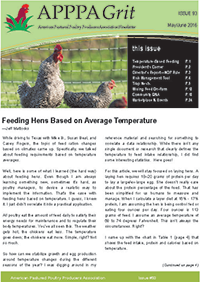Holistic Approach to Pastured Poultry BiosecurityPublished in APPPA Grit Issue 87 (May/June 2015) by Susan Beal DVM, Mike Badger, and Terrell Spencer The primary sources of infection of poultry with Avian Influenza appear to be coming from migratory waterfowl and husbandry practices by humans. Waterfowl are ubiquitous hosts for low pathogenic viruses, but it’s the high pathogenic form that ultimately infects poultry with a high mortality rate.Producers should focus on keeping the flock’s immune system at optimum health and preventing contact with the disease through sound biosecurity practices. Cool, wet weather favors the viability of the virus while heating, drying, and disinfecting destroys it. The virus is extremely sensitive to ultraviolet light – sunshine. Transmission is often by way of direct contact and droplets such as nasal discharges. Keeping the flock’s immune system at optimum health
Protecting the flock with physical biosecurity
Receive Free PDF Issue of APPPA Grit Newsletter
| Membership At a Glance
Consumer Guide
|

 APPPA publishes a weekly newsletter to bring tips, news, and thoughtful commentary about pastured poultry to your inbox. Subscribe and receive a free issue of our bi-monthly trade newsletter, APPPA Grit. We mail APPPA Grit to all paid members bi-monthly.
APPPA publishes a weekly newsletter to bring tips, news, and thoughtful commentary about pastured poultry to your inbox. Subscribe and receive a free issue of our bi-monthly trade newsletter, APPPA Grit. We mail APPPA Grit to all paid members bi-monthly.